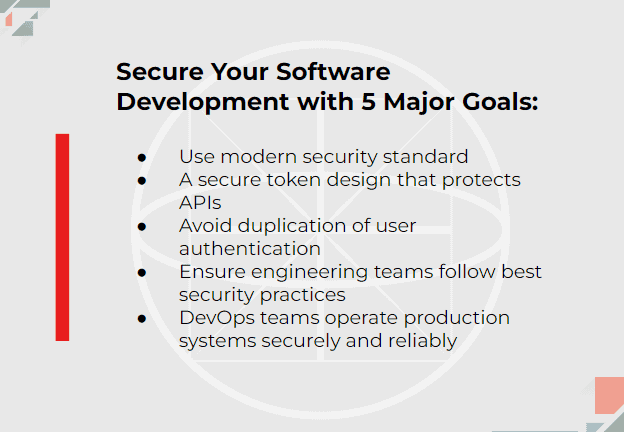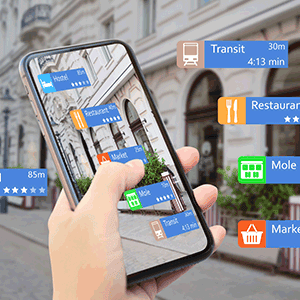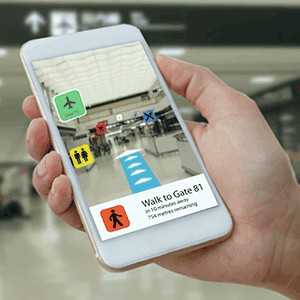Category: Business
Many of us interact with Artificial Intelligence (AI) on a daily basis without even realizing its presence. From email spam filters to face IDs used for unlocking our phones and from smart home devices to Amazon feed recommendations, AI has become a household name today.
The examples of AI we encounter every day are seemingly infinite! Now, imagine the myriad ways AI facilitates business development!
“87% of enterprises believe that AI and ML will help them achieve business goals centered around growing revenue, boosting operational efficiency, and improving customer experiences.”
With its capability to automate processes, enhance productivity, forecast trends, and personalize experiences, AI has become an invaluable asset for businesses of all sizes.
Key Areas Where AI Can Contribute to Business Development
1. Business Growth: Data-Driven Decision Making
Machine learning (ML) algorithms running behind AI analytics engines can process and analyze vast amounts of data quickly and accurately. By deploying AI-based analytics tools, you can extract contextualized and valuable insights from your data to make well-informed and timely business decisions.
Benefits of AI-driven business data analysis:
- Understand customer behavior and preferences, market trends, and sales performance
- Optimize business operations and resource allocation, identify new opportunities, refine marketing strategies, and improve your competitive positioning.
- Make proactive business development decisions powered by reliable data.
2. Customer Gratification: Personalized Experiences
By analyzing customer purchase history, behavior patterns, preferences, and interests, you can tailor your offerings to individual needs. In-depth personalization enhances customer satisfaction, boosts loyalty, and drives customer acquisition.
- Intelligent customer service solutions such as AI-powered chatbots and virtual assistants enhance customer experience by providing prompt and personalized support.
- Insights derived through AI can be used to personalize website experiences, optimize conversion rates, and improve customer engagement.
- AI helps deliver personalized customer recommendations and individualized experiences across multiple channels.
3. Marketing Automation: Tailored Content & Targeted Campaigns
AI-powered marketing automation helps streamline your entire marketing efforts. Thanks to data and algorithms, AI-based marketing automation makes sending personalized content to your customers easier.
Here are a few ways marketers can leverage AI to automate their processes:
- Personalization: Analyze customer data, predict consumer behavior, identify patterns and trends, and send personalized messages to your customers.
- Email Automation: Analyze the performance of your emails in real time and use the data to improve your next set of emails.
- Lead Scoring: AI can be used to analyze your data to determine which leads will likely become customers. This saves your time and money on lead scoring and improves the quality of your leads.
- Lead Nurturing: AI can also automate your lead nurturing process by effectively guiding leads through the sales funnel until they are ready to purchase. This will boost your conversion rates.
- Channel Optimization: With Al algorithms, your marketing team can easily identify which channels are the most effective in reaching your target audience. This allows you to allocate sufficient time and funds to channels with the best ROI.
- Customer Service & Communication: Using AI to respond to customers instantly will improve your customer’s experience and satisfaction while saving time and resources. For instance, AI-powered chatbots can answer frequently asked questions, recommend products, and process orders faster than a human service agent.
4. Sales Performance: Driving Conversion & ROI
AI-powered sales tools can help businesses identify the most promising leads, prioritize sales activities, and personalize sales pitches. By analyzing customer behavior and predicting their needs using AI, companies can provide more effective sales support and create compelling sales pitches.
Here’s how AI can transform your sales process:
- Data Enrichment & Analysis: Data enrichment refers to the process of deriving data from third-party sources and pulling it into an organization’s database, typically a CRM. Leveraging AI will allow you to bring all your customer context in one place. For instance, with a single source of customer information (in your CRM), you can easily understand lead sentiments and topics of interest. That way, you can score and prioritize your leads and personalize your selling strategies.
- Conversation Intelligence: AI-powered conversation intelligence tools allow you to analyze sales calls and pull key insights, recognize the context within a conversation, and uncover the why behind sales performance.
- Sales Enablement: Sales enablement, the process of equipping your salespeople with the right tools and resources to close more deals, can be automated and optimized with AI. For instance, AI helps build and manage dynamic content libraries that can surface relevant information when necessary and even automatically pull the data from these libraries into sales pitches and proposals.
- Pipeline Management & Forecasting: AI helps reduce the probability of inaccuracies in your sales team. With an AI-driven forecasting solution, you can analyze existing data and gain insights into deals and overall pipeline, build forecasts to draw valuable insights and make improved decisions.
- Sales Engagement: Sales engagement involves all the buyer-seller interactions within your sales process, right from initial outreach to customer onboarding. There are two ways AI can help you streamline this process. Firstly, AI helps analyze your data and insights to understand customer needs and pain points. Secondly, AI aids in personalizing and automating your customer interactions.
5. Process Automation: Automate Repetitive, Time-Consuming Tasks
AI helps automate your most time-consuming routine operations and free up your workforce for more critical tasks. Transferring large volumes of repetitive work from humans to automated systems increases your productivity, accuracy, and responsiveness while minimizing the error rate.
Here are a few examples of AI in business process automation:
- Inventory Management: AI-integrated inventory management software helps with accurate stock level maintenance, effective order management, improved demand forecasting, and better supplier management.
- Data Entry & Update: AI-based data entry involves using software systems that leverage ML, NLP, OCR, computer vision, or other AI techniques for extracting, validating, transforming, or entering data from various sources, such as PDFs, documents, images, audio, or web pages.
- Price Optimization: AI can help you set optimal prices for your products and services by analyzing your customer demographics and spending patterns, historical data, market trends, supply and demand changes, and competitors’ prices.
- Reporting: AI helps automate your report generation process by extracting data from different business systems and relevant documents. It also helps perform necessary data manipulations, assemble reports in designated formats, and send them to relevant stakeholders based on the content.
- Fraud Detection & Prevention: AI-based automation allows your financial professionals to reduce errors in transactions and prevent miscalculations and delayed payments.
6. Innovation: New Business Models Expansion
Artificial Intelligence is basically focused on business expansion and helps unlock new business models that were not possible before.
Here are some of the ways organizations today are making that shift and reaping the benefits of AI in a more practical way.
- Unlock New Opportunities: Predictive analytics solutions leverage AI to identify new revenue streams and opportunities, such as upselling and cross-selling products and services.
- Develop New Offerings: AI-based customer insights are used to develop new products and services that meet the needs of their customers, resulting in increased revenue and growth.
- Efficiency & Productivity Gains: AI-based analytics helps warehouses, shipping and transportation companies, fulfillment centers, and similar businesses with fuel optimization, predictive maintenance, and route optimization.
- Coding & Application Modernization: Companies are using AI for application modernization and enterprise IT operations by employing AI to automate coding, deploying, and scaling. IBM’s Project CodeNet, for example, is a large dataset developed for teaching AI to code.
- Convergence with Other Technologies: Converging AI with other technologies, such as IoT, helps create a new paradigm of business models. For example, real-time data collected by IoT sensors attached to equipment or vehicles can be used to rigorously train AI models, which will ultimately help businesses make fruitful decisions.
Download Our Free Case Study Report Now: How Combining AI with the client’s Litigation Strategy helped reduce the Average Case Settlement Time to 1-2 days at a settlement cost of $15000.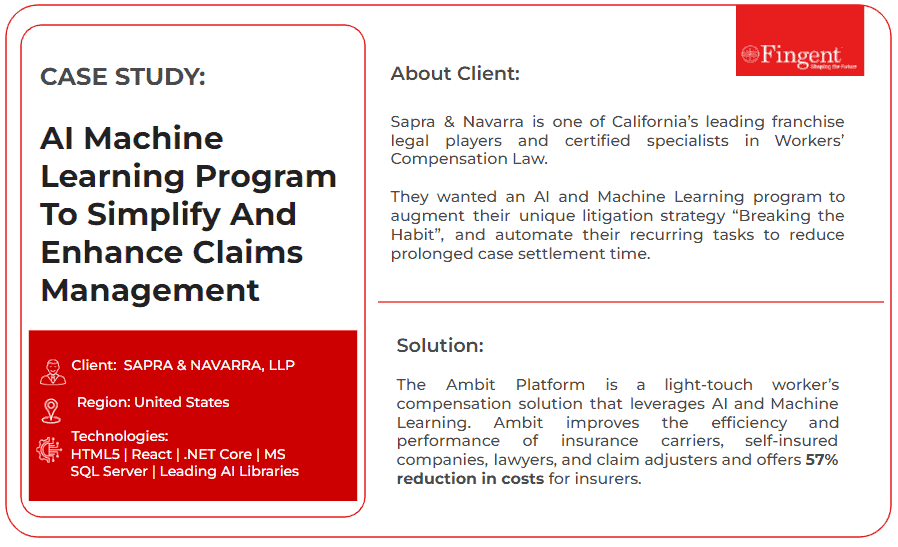
AI Use Cases in Business Development
Here are some significant AI use cases impacting major industries:
1. Healthcare
Healthcare organizations are using AI to improve the efficiency of all kinds of processes, from back-office tasks to patient care.
- AI computer-assisted documentation: This allows clinicians to efficiently maintain medical records.
- AI virtual nurse assistants: Automate patient question-answering, clinical appointment scheduling, and report-sharing with physicians or surgeons.
- Detect & Minimize Dosage Errors: Monitor and flag errors in how a patient self-administers medications in order to enhance patient health outcomes and reduce healthcare costs and hospitalizations.
2. HR & Talent Management
AI influences almost all of HR operations and service delivery, including recruiting, learning and development, and talent management.
- Recruiting: AI-based profile sourcing from recruitment websites, automated screening of candidates using facial recognition, and AI-based interviews.
- Employee Onboarding: AI-powered bots can accelerate employee onboarding processes by providing quicker access to knowledge, personalized results, real-time assistance, Q&A support, and enhanced collaboration.
- Payroll Processing: Automation of repetitive and error-prone payroll processing tasks such as recording overtime, keeping track of timesheets and leaves, and calculating incentives or commissions.
3. Banking & Financial Services
Custom AI banking solutions help reduce banking costs, mitigate financial risks and frauds, and improve the overall banking experience for customers.
- Reduce Manual Work: Automating routine processes such as KYC update, data extraction, validation, etc., will speed up processing times, reduce error rates, and improve regulatory compliance.
- Transaction Monitoring & Fraud Prevention: In digital banking, AI can be used to monitor user transactions, spot suspicious activities in real-time, and take quick measures to address the risks.
- Financial Planning: AI banking chatbots can interact with customers to assist them with financial planning tasks such as setting financial objectives, budgeting, identifying new investment opportunities, etc.
4. Education
AI in education focuses on developing new solutions for teaching and learning catering to different situations. The ultimate goal is to facilitate learners with flexible, personalized, and engaging learning experiences.
- Personalized Learning: AI helps educators understand the needs of every learner/ student so they can quickly come up with tailor-made learning plans for each student.
- Course Creation: Several online learning platforms use AI to generate smart content and courses that include immersive visualizations, simulations, bite-sized lessons, and other interactive forms of content.
- AI-Based Tutorials: AI-driven tutorials provide additional support to students in understanding their study materials. With these tutorials, students can learn complex concepts by breaking them down into simple learning modules.
5. Retail
The application of AI in the retail industry translates to better experiences, accurate forecasting, and automated inventory management.
- Demand Forecasting: AI can track and analyze customer data to improve demand forecasting, make pricing decisions, and optimize product placement.
- Inventory Management: AI-based inventory management software can automatically track out-of-stock items, missing inventory, pricing errors, expiring stocks, surplus inventory, etc.
- Returns Management: Intelligent bots can reduce the volume of manual work involved in managing and processing returns by collecting necessary information from customers, guiding them through the return process, sending notifications, and updating inventory databases.
How Fingent Helps Organizations Leverage AI for Business Development
“94% of global business leaders believe AI is critical to success over the next five years.”
Artificial intelligence has a unique and powerful role to play in addressing many of the challenges presented to us today. The question is no longer about adopting AI for basic process automation. It is now about unleashing the potential AI holds to drive new opportunities for our businesses, employees, and society at large.
Fingent offers custom AI software development services to accelerate your business’s growth and profitability. Our AI software development experience spans multiple industry segments, including education, corporate learning systems, litigation, human resources and people management, insurance, retail, real estate, and more.
If you are planning to build custom AI software for your business, want to know more about the scope of AI in business development, or want to upgrade from legacy software to a modern technology platform, feel free to connect with our team.
Stay up to date on what's new

Featured Blogs
Stay up to date on
what's new



Talk To Our Experts
- Companies can save 20% of the total annual cost if they migrate to the cloud.
- Hyperscaler Cloud Services can enable businesses to experiment, build, innovate, and run any form of application.
- Hyperscaler adds immense value when creating custom software applications with a specified focus on the data center hardware and software needs.
Organizations of a variety of sizes are now able to reinvent how they operate and move more quickly and more agilely, thanks to the cloud. The move to the cloud has fundamentally changed how we perform our jobs, communicate, and interact. It is quickly becoming a requirement to be competitive in today’s digital environment.
Custom software applications powered by the cloud are a force to be reckoned with, and the benefits become manifold with hyperscalers like AWS, Azure, and Google. What are these hyperscalers, and how can they supercharge your business? Let’s find out.
What are Cloud Services?
In very simple terms, cloud computing is access to computer services such as servers, storage, databases, networking, software, analytics, intelligence, and more by means of the cloud (the Internet). With cloud computing, you can store and access data and programs on remote services hosted on the internet rather than the computer’s hard drive or local server. Cloud computing can be done with cloud services, which are essentially software programs that are hosted by third-party providers who make them available to users over the internet.
Studies recently revealed that, on a worldwide scale, 94% of all companies will use some kind of cloud computing service in 2023 to help them run their business operations. This is a 14% jump from 2020.
A major reason for this wide shift from on-premises servers of the companies to cloud providers is the ‘Pay as you go’ service offered by them, meaning that you only have to pay for the service that you are utilizing. However, the cloud offers more, much more!
How Does the Cloud Work and How Does it Benefit Businesses?
Just like any other IT solution, cloud services also rely on hardware and software. Users typically need just a computer, a stable internet connection, and operating systems to access cloud services.
Benefits To Businesses:
- Cost Reduction: This is a major factor that makes this technology desirable. On average, 20% of the total annual cost can be saved by companies if they migrate to the cloud.
- More Storage: Many tools are available on the cloud with the sole purpose of providing more storage capacity. Some examples include Dropbox, OneDrive, Google Drive, and iCloud Drive.
- Higher Security Barricades: Another attractive feature of cloud services is their tight security regulations. A report by Salesforce states that 94% of businesses claimed to have seen an improvement in security after adopting cloud services.
Read more: Advance your business software development with Cloud Native. Download the complete 451 Research now and strategize a successful Cloud Native adoption process.
Hyperscalers: What Are They, And How Do They Add Value To Cloud Services?
Hyperscaler got its name from the data processing method known as “hyperscale computing,” which allows software architecture to expand and scale on an enterprise level. Hyperscalers enable their clients to experiment, build, innovate, and run any form of application—from a social network to a smart city to online banking—while controlling costs and operating with agility by offering users access to a ready-made, scalable infrastructure. Some famous examples of hyperscalers are Amazon Web Services (AWS), Microsoft Azure, and Google Cloud Platform (GCP). These technologies combined are reported to have an estimated 65% control over the cloud market.
Benefits Of Hyperscaler Cloud Services:
- Scalability: They can provide virtually unlimited computing resources, which enables organizations to scale their services and applications swiftly without worrying about hardware constraints.
- Global Availability: Users can easily access content with lower latency through hyperscalers, which boosts efficiency and user satisfaction.
- Security: Hyperscaler clouds provide a high level of security by frequently investing in infrastructure reliability, disaster recovery, and cybersecurity.
Value Added By The Big Three: AWS, Azure, and Google
Let’s now talk about these three hyperscalers:
AWS: Four primary elements of value—cost savings, employee productivity, operational resilience, and business agility—are measured and tracked by AWS to assist enterprises in developing an in-depth case for the cloud.
Azure: Azure is the only consistent hybrid cloud that delivers exceptional developer productivity, offers extensive, multi-layered security, including the most conformity coverage of any cloud provider, and costs less than AWS.
Google: Google’s solution provides a complete data foundation for unifying all workloads and overseeing the entire data life cycle. It can process data anywhere and is designed with and for AI, so you can obtain the most up-to-date tools for machine learning analysis, prompting, adjusting, training, and deploying unique foundation models—all while being connected to your business data.
How Can Custom Software Applications Benefit From These Hyperscalers?
Hyperscalers generally oversee the in-house technical skills of an IT team needed to customize data center hardware and software in accordance with the company’s business model and applications. This adds immense value when creating custom software applications.
AWS:
AWS offers many tools you can use to build custom SaaS applications and third-party SaaS solutions.
- Cognito: enables organizations to provide extra sign-in alternatives to their users.
- AD Connector: adds an extra degree of security.
- Quicksight: is a BI solution that you can use to provide simple insights to the people who work with you.
- Cost Explorer: displays and analyzes your costs and operations.
- Aurora Serverless: takes care of routine database chores, including provisioning, patching, backup, recovery, failure detection, and repair.
Azure:
Azure services can assist you throughout the process of custom software application planning, development, delivery, and operations.
- Github: It is a programming solution for collaboration and version control that allows you and others to work on projects from anywhere in the world.
- Azure Pipelines: Works with any language or platform and is used to simultaneously deploy services to multiple targets.
- Azure Boards: This tool lets teams organize, monitor, and talk about their work across the whole development cycle.
- Azure Monitor: This helps improve the responsiveness and availability of your services and apps.
- Visual Studio: This can be used to connect applications and services to Azure and create services that operate in the Azure cloud.
Google:
To help you create high-quality apps as quickly and dependably as possible, Google provides a wide range of resources.
- Firebase: It is used for cloud communications, performance monitoring, and authentication validation.
- Web: It offers information to assist you in enhancing your site’s organization, how it appears in Google searches, and the effectiveness of its user interface.
- The Cloud: Here, you can access services like BigQuery (for processing large, ready-only data sets), Compute Engine, and Cloud Storage.
- Tensor Flow: This tool is mostly used for machine learning and gives developers access to a variety of workflows and high-level, logical APIs to build machine learning models in a variety of languages.
Why Should You Choose Fingent?
Fingent is one of the top providers of technology solutions around the globe right now, serving customers from four different continents. To assist you with your projects, we provide top client-centered personnel who can help you with any of the three types of Cloud services – SaaS, PaaS, and IaaS.
With our team of experts, you can scale up or down as you need and manage and integrate cloud environments according to your business needs. We provide excellent pre- and post-development support by monitoring performance and making any necessary adjustments, and we are accessible at any level of development.
Give us a call, and let’s talk about how to get your business to succeed on the cloud.
Stay up to date on what's new

Featured Blogs
Stay up to date on
what's new



Talk To Our Experts
In the ever-evolving landscape of cybersecurity, application security stands as the impervious armor that shields your organization’s digital fortresses. Imagine your organization’s applications as the kingdom’s gates – if left unguarded, they become vulnerable entry points for malevolent forces. We understand that as a CIO, CTO, or IT Manager, you take your duty seriously to ensure these gates are fortified.
In order to assist you in this regard, in this blog, we will delve into the realm of application security and shed light on the importance of each layer of defense. We will also explore how a proactive approach to application security can save your organization from potential disasters.
Why Application Security is a Concern
In an era marked by rapid digital transformation, applications have become the lifeblood of businesses. They manage sensitive data, perform critical functions, and are often the first line of interaction with customers. However, these very assets can be exploited if not adequately secured.
Just as the strength of a fortress determines its ability to withstand attacks, the security of your applications dictates your organization’s resilience against cyber threats. Data breaches, unauthorized access, and system vulnerabilities have become common adversaries in today’s digital age.
Picture this: By 2023, ransomware attacks had hit an astonishing 72% of businesses worldwide, marking a significant rise over the past five years and setting a record high. This emphasizes why application security must be at the forefront of your defense strategy.
The consequences of such breaches are dire, leading to financial losses, reputational damage, and regulatory penalties. According to studies, in 2023, data breaches cost companies worldwide an average of USD 4.45 million, showing a worrying 15% increase in just three years. This statistic underscores the urgency of investing in robust application security measures. So, how can you be prepared?
The Building Blocks of Application Security
The Foundation: Architecture Choices
Every castle begins with a strong foundation, and the same principle applies to application security. The architecture choices you make at the outset are akin to building a formidable fortress. An ill-conceived architectural design can leave cracks in the walls for attackers to exploit.
Just as an architect meticulously plans the layout of a castle, your development team should consider security measures when designing your applications. A single weak link in your architectural chain can lead to disaster. Empirical data reveals that a significant 50% of vulnerabilities stem from poor architectural decisions.
Investing time and resources in designing secure architecture is a proactive approach that can significantly reduce the likelihood of security breaches down the line.
1. Building Strong Walls: Coding Practices and Code Organization
The walls of a fortress serve as the primary defense against intruders. In the world of application security, coding practices and code organization are your virtual walls. Sloppy coding practices create chinks in the armor, allowing malicious code to infiltrate your application.
What can you do?
Imagine coding as the masonry work – each brick (line of code) must be laid meticulously to ensure structural integrity. Security breaches can often result from code vulnerabilities. Ensuring your development team adheres to secure coding practices is akin to reinforcing your fortress walls.

Implementing secure coding practices, conducting regular code reviews, and enforcing coding standards can mitigate vulnerabilities. Training developers in secure coding practices is a crucial step in enhancing your application’s security posture.
2. The Gates and Drawbridges: Library Updates
Just as a castle’s gates and drawbridges are essential entry points, your applications rely on third-party libraries and components. These elements, if left unguarded, can become weak points in your security defenses.
Applications often rely on third-party libraries and components. A concerning fact is that out of about 433,000 websites analyzed, 77% of them use at least one front-end JavaScript library with a known security issue.
Think of libraries as the mechanisms controlling the gates of your fortress. Failing to update them is like leaving the drawbridge down, making it easy for attackers to breach your defenses. Regularly updating these libraries is similar to raising the drawbridge and securing your gates against unwanted visitors.
Additionally, employing automated tools to scan for vulnerabilities in third-party dependencies can help identify and address issues promptly.
3. The Watchful Guards: Application Security Program Management Solutions
Medieval fortresses had vigilant guards patrolling the battlements. Similarly, modern organizations require robust application security program management solutions to keep a watchful eye over their digital assets.
A stark reality: 66% of CIOs are ramping up their investments in cybersecurity. This surge in adoption underscores the growing recognition of the importance of a structured approach to application security.
So, think of these solutions as your digital sentinels, tirelessly scanning for threats and vulnerabilities. These systems serve as your first line of defense, ensuring that potential threats are identified and neutralized promptly.
Read more: A CTO’s Guide To Secured Software Development
How Fingent Helps Fortify Your Digital Kingdom
Without a robust application security strategy in place, your organization is vulnerable to attacks that could have far-reaching consequences.
Just as medieval kings relied on skilled architects, craftsmen, and sentinels to protect their castles, you can depend on Fingent to safeguard your digital kingdom.
At Fingent, we understand the importance of application security, and our expertise in secure architecture design, coding practices, library updates, and application security program management ensures your digital fortresses remain impenetrable. With a deep commitment to security, we offer cutting-edge solutions to protect your digital assets.
In this age of digital warfare, application security is not just an option; it’s your shield against an ever-growing army of cyber threats. Fingent can be your trusted ally in this digital battlefield.
Stay up to date on what's new

Featured Blogs
Stay up to date on
what's new



Talk To Our Experts
Home-grown might be the way to go when it’s to be put on your dinner table, but does it apply to your business as well?
The need for complete digitization of business processes has become a necessity in today’s day and age. Due to this demanding criterion, some businesses have taken it upon themselves to cultivate their own personal, home-grown software programs. This has proved to be exponentially advantageous to some businesses. The important question here is: Although your home-grown software helped you take a big step forward, is it going to hold up to other demands of the future?
What Is Home-Grown Software?
Home-grown software, also known as legacy software, is generally a custom-tailored software program fabricated by a consumer or software development team to complete business processes. It is typically created internally from scratch, and the reason for its creation is the lack of suitable commercial packages that fit a specific business need. These programs are affordable and can be extremely handy.
Although home-grown technology has proven to be an excellent path to customize business processes and cut costs in the past, it does not hold the same weight in the incessantly evolving market integrated with evolving advanced technology. The world’s capacity for technology and innovation is rapidly increasing, which places a lot of pressure on businesses that aim to progress. Due to this rise in customer expectations, most businesses are forced to migrate from their old home-grown software to modern cloud-based software.
Is It Time To Upgrade Your Home Grown Software Or Replace It?
Most software tends to fall apart over time, whether it is due to the changing market or its inability to scale as businesses grow. When this happens, you are faced with two choices: to either upgrade your software program or completely replace it. Here are a few indicators to look out for if you are not sure when is the right time to update or replace your legacy software:
- Unending Updates: If the “system update” notification starts popping up too many times, it’s time to consider an upgrade. When a system updates itself, it needs to shut down completely, and this directly affects the productivity of your employees. If there is an inconsistent workflow, motivation to work dies down.
- Security Scares: If your legacy software is incapable of encrypting and protecting your business data, you can potentially become a target for hackers and other security threats. Hence, security is a vital factor in determining whether you need to replace your software or update it.
- Trendy Technology: Analyze if your legacy software can keep up with current technology. If your home-grown software is unable to compete with modern technology and the technology it uses to run is outdated, finding personnel or employees to maintain it becomes close to impossible. This will add to your expenses and ultimately result in a business loss.
Read more: Take steps to modernize your applications before they fall apart. Here are excerpts from a CTO on Legacy Application Migration!
Technical Debt
Technical debt, also known as tech debt, is the cost businesses pay when they do not fix problems that will affect them in the future. It is essentially the price you pay for not foolproofing your business and its aspects. Tech debts are generally caused by insufficient information about company needs, pressure to release software quicker with quality checks, and underestimating the need for quality codes.
It can be said that they are shortcuts taken during software development; they tend to accumulate over time and can affect business. Technical debts take the form of codes that are difficult to read, maintain, and scale or technical infrastructure that is outdated and in need of updating. Postponing the process of adding extra features and maintaining poor records of documentation are also forms of shortcuts.
Consequences Of Technical Debt
There are several consequences of tech debt: increased cost for fixing problems that may arise; lower quality of service leading to poor customer service; tainting company image and reputation; stunted scaling, which leads to stagnant business; death of innovation and integration; poor security; obstructed workflow resulting in lower employee morale; and finally, overall increased risks. These consequences cannot be overlooked because if you ignore their existence in the beginning, they will stack up and slowly poison your business. Although cutting costs in the development phase of your home-grown software may prove to be economical initially, it is bound to cost you more money to repair in the long run. The average cost overrun of an IT project, according to the Harvard Business Review article “Why Your IT Project May Be Riskier Than You Think,” is 27%.
Integration For the Future
Every business owner plans their business with the bigger picture in mind. It is no surprise that the path of technology is decked with Artificial Intelligence and Machine Learning, among many other advanced technologies. When creating software, it is of utmost importance to code it with features that help it integrate with other systems and advanced technology.
As a business owner, it is wise to keep all the cards on your side, and the advantages of Artificial Intelligence and Intelligence Automation cannot be overemphasized. The homegrown system you create must have the capability to sync with these evolving applications and intelligence tools. If you are not willing to completely abandon your legacy software and wish to update it instead, remember to consult the right professionals who can help you modernize your system to be up-to-date with evolving technologies and allow seamless incorporation.
Creating and maintaining the perfect home-grown software can be quite challenging. Hence, most business owners prefer to partner up with a reliable service provider to meet their business needs. Developing custom software that targets your specific needs and is customized to cater to them is beneficial for your business.
Just remember to be mindful of the choices you make while developing it. If you sense your legacy software falling short and notice that it is time for change, be bold and take that leap. Whether it is to replace the home-grown system or update it, keep your business’s future in mind and make your decision.
Talk to our experts and allow us to help you figure out the best solution for your business.
Stay up to date on what's new

Featured Blogs
Stay up to date on
what's new



Talk To Our Experts
Stay up to date on what's new

Featured Blogs
Stay up to date on
what's new



Talk To Our Experts
A strong technological backbone – that is what is required of businesses today. From simple record-keeping tasks to complex future planning tasks, advanced technology can support a business and allow it to function smoothly. ERP solutions were designed exactly for this purpose: to boost the capabilities of businesses. To understand this better, let us take a short tour into the world of cloud-based ERP solutions and see how they benefit companies.
What Is Cloud-Based ERP and How Does It Work?
Cloud ERP or Enterprise Resource Planning Software is a modular software system designed to integrate all the core processes in an organization. It acts as the IT backbone of a company and is accessible over the Internet. The demand for cloud-based ERP systems has consistently grown because of their ability to access and analyze massive amounts of data in near real-time. This means that as new data is added to the system, the ERP system analyzes this data consequently and produces results spontaneously.
Cloud ERP systems are built with vast combinations of technologies connected by high-speed internet networks. They are always online, and the ERP vendor takes care of any security updates. These systems have a wide range of business applications to help workflow efficiency with exclusive attention to a positive customer experience and boosted profits. Businesses can choose from different deployment modules and settings according to their needs. This keeps the business team focused on its core operations and will help streamline workflow to meet the company’s goals.
Pros And Cons Of Cloud-Based ERP Solution
As with any solution, it is wise to consider both the pros and cons of Cloud-Based ERP before investing in it.
Pros –
- Scalability: This is perhaps Cloud ERP’s most impressive feature. Its ability to seamlessly scale as a company’s needs progress is spectacular.
- Mobility And Access of Information: Cloud-based ERP software permits smooth access and control of information and company data through ERP-enabled mobile devices, making it easier to access important data from wherever and whenever necessary.
- Real-time Analysis: This is a priceless tool for businesses today, and with cloud ERP, companies have the power to access information as it becomes available allowing them to make faster and more efficient decisions.
Cons –
- Long-Term Costs: Cloud ERP works best for businesses with a clear long-term vision. If you expect your business to grow rapidly over time, then the cost of the cloud-based system will be worth it. On the contrary, if you expect your business to remain static, then a regular traditional ERP service is best suited for you.
- Absence Of Customization: A cloud-based ERP system may have a rigid template, and when you implement your ERP system in the cloud, your ability to customize it will be stunted. This system is extremely beneficial for smaller businesses, while larger ones might benefit from having an ERP expert to deal with this.
- Connectivity Issues: Uploading all your data to the cloud will mean that you need to have a strong internet provider. Without a smooth connection to the cloud, your workflow cannot run easily, and this will ultimately lead to significant issues.
What Are The Top Benefits Of Implementing Cloud ERP?
There are innumerable perks to implementing Cloud ERP and listed below are five of the most beneficial:
1. Quick And Painless Upgrades And Updates: Every ERP software requires periodic updates, and this process can be tedious when it falls under your responsibility. With cloud ERP, the service provider takes on the duty of upgrading your software regularly, making it hassle-free for you.
2. Real-Time Analysis: As we saw earlier, cloud ERP’s real-time data analysis feature is its strongest suit. It helps employees access important information as it becomes available and keeps them up-to-date with business decisions.
3. Simplification And Automation: With the implementation of cloud ERP, companies can consolidate previous legacy applications, integrate all existing and new applications, simplify workflows, and intelligently automate processes.
4. More Security And Less Data Loss: Data security is a growing concern for most businesses nowadays. To tackle this issue, cloud-based ERP vendors can deliver enterprise-level security and compliance to safeguard your data. Cloud-based ERP systems also have a robust backup and recovery plan that ensures that no data is lost during upgrades or security breaches.
5. Free Up Internal IT Teams: While Cloud ERP software vendors do all the mundane technical tasks, internal IT teams have more time to focus on other, more important responsibilities such as hardware maintenance and product support. They will be able to concentrate on higher-value activities and spend only a fraction of their time on troubleshooting and routine ERP check-ins.
Read more: A Complete Guide On Enterprise Resource Planning!
How To Know If Your Company Needs Cloud ERP
Identifying your company’s needs and recognizing when to accept help is crucial for your business’ survival and growth. Seeing how vital Cloud ERP can be to a company’s progress, let’s look at a few signs that might indicate that your company needs Cloud ERP software.
1. If you use different solutions for different processes: When you notice that different departments in your company use different solutions to perform their tasks, it can be a clear sign that you need to find a unified solution that all these departments can access together. Cloud ERP can unify multiple processes and integrate every business function into a single database.
2. When every task is manual and not streamlined: When a company heavily relies on traditional and ancient legacy systems, its speed of growth can diminish. Manual tasks are extremely time-consuming and are at greater risk for human error. To help with this, ERP systems can automate or streamline these everyday tasks to save money and boost efficiency.
3. If the retrieval of information takes forever: Time flows faster today, and if your business fails to function at lightning speed, you’re bound to miss out on profits. Your staff members should be able to retrieve key data immediately, without any delays or the need to search for it in multiple places. A cloud ERP system offers a full-blown, all-inclusive view of the entire business operation no matter when you need it, making it effortless to access the correct data at the right time.
4. When sales and customer service are suffering: Your customer is the top priority of your business. If customer experience is deteriorating, then you have to do everything in your power to rectify it. As your company grows, managing inventory becomes more challenging. This is where Cloud ERP can help you. Due to its unified processing, staff in every department will have access to the same, up-to-the-minute information about the company. This makes it easier for customer-facing reps to pull up customer information quickly. To do one better, customers can even check their account status information, while warehouse managers can check if stock is getting low and can reorder.
Investing in Cloud ERP can be a costly affair at the start, so analyzing your business needs thoroughly before making any decision is very important, including your goals for the next few years.
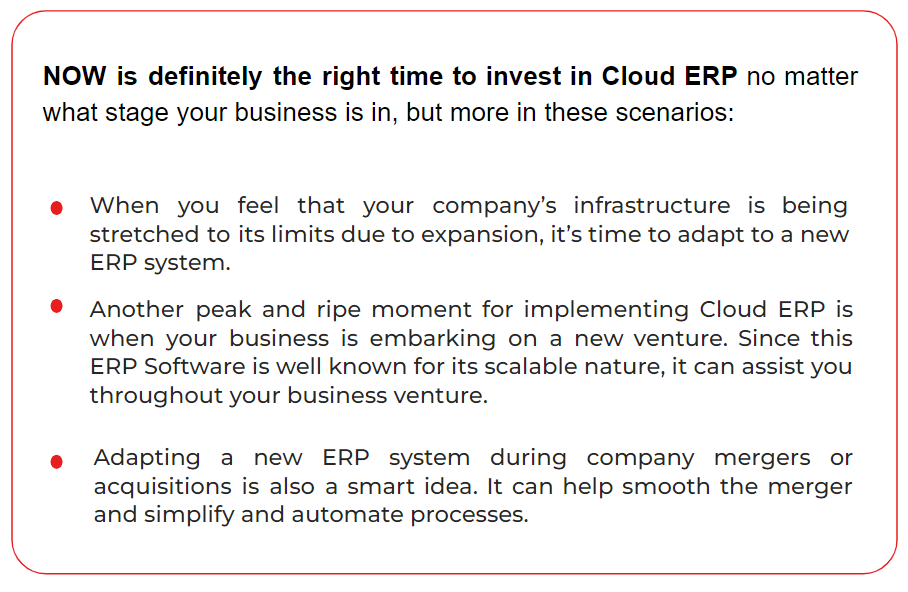
Cost Factors With Regard To Cloud ERP
Profits are what it all boils down to in business. If you find yourself spending more and more money on business maintenance, you need to stop and take a good look at your expenditures. Investing less and making more is the right way to run a business, and Cloud ERP can help you reach that goal. This software has a great capacity for streamlining and optimizing your operations and business processes without the need to spend heavy amounts of money on data security.
Of course, Cloud ERP integration costs money, too. Some factors that will affect the cost are:
- licensing costs
- number of integrations required
- complexity of the ERP system
- volume and quality of data
- extent of customization required
- integration tools and technologies
- IT manpower
It would be best to speak with an experienced ERP integration specialist who understands your needs and can provide the best solution for your budget.
Choosing The Right ERP Vendor
Once you have analyzed your business needs, the next step is to look for your ERP vendor. The single most important criterion for selecting the right ERP vendor is to check if they are the most functional fit for your organization.
Ensure to partner with someone with a good track record in ERP implementations. Check their references, ask for case studies, and get to know how well they understand the needs of your industry. A good vendor will communicate with you and offer post-implementation support.
How Fingent Can Help
As an exclusively client-centered service, Fingent brings you a team of qualified and brilliant professionals to make your ERP solution implementation process simple and perfect. Our specialists use top-notch and advanced technological tools to help our clients. We also offer great post-implementation assistance by keeping track of performance and staying in contact with clients through user comments to make any necessary fixes.
Give us a call, and let’s discuss your needs.
Stay up to date on what's new

Featured Blogs
Stay up to date on
what's new



Talk To Our Experts
In today’s ever-evolving business landscape, the concept of “Digital-First” isn’t just a buzzword; it’s a strategic necessity. For CIOs, CTOs, and IT Managers, embracing digital transformation isn’t just a choice; it’s a critical strategic move. It’s the pathway to gaining a competitive advantage, exceeding customer expectations, leveraging data for success, accessing global markets, and fortifying your digital defenses.
In this blog, we’ll explore why launching your business with cutting-edge technology is of paramount importance.
Why Starting with Cutting-Edge Technology Matters
Here are some key aspects and applications of Digital first:
1. Online Presence: Your Digital Storefront
In an increasingly online world, your digital presence is your storefront, and its impact is profound.

If your business lacks a robust online presence, you’re missing out on a significant slice of this digital pie. Your online presence is your digital storefront and first impressions matter. It’s the place where your customers interact with your brand. Think of it as the front window of a physical store – it needs to be inviting and informative.
Applications: E-commerce, Social Media, Content Marketing
2. Customer-Centricity Rules
PwC’s Global Consumer Insights Survey reveals that 43% of consumers plan to increase online shopping in the next six months. The study further said, “Consumers are seeking less friction…they’re continuing to experiment with the next generation of digital platforms, including the metaverse.” Starting with cutting-edge technology allows you to provide those seamless, personalized experiences that customers crave while they shop online.
3. Mobile-First Design: Meeting Customers Where They Are
With the proliferation of smartphones, being mobile-friendly isn’t just a choice; it’s a necessity. Oberlo reports that mobile devices account for 55.5% of web traffic globally, surpassing desktop usage. Ignoring mobile users means missing out on more than half of your potential audience. Consider mobile devices as the primary means through which customers engage with your brand – like a shop accessible anytime, anywhere.
Applications: Responsive Websites, Mobile Apps, SMS Marketing
4. Competitive Imperative

Jorge Lopez, a distinguished VP analyst at Gartner, says, “Boards of directors (BoDs) have reached a point where digital business strategy and overall business strategy are one and the same.” It’s clear that being “Digital-First” is no longer a choice; it’s a competitive imperative.
5. Security and Privacy: The Digital Trust Factor
As digital interactions increase, so does the importance of security and privacy. Cybersecurity Ventures predicts that cybercrime will cost the world $6 trillion annually by 2021. Neglecting security is a gamble on your business’s survival. Cyber threats are rising! The worldwide expense of a data breach in 2023 stood at $4.45 million, reflecting a 15% rise over a three-year period. Cyberattacks are a growing concern for businesses and consumers alike.
Applications: Encryption, Multi-Factor Authentication (MFA), Regular Audits
6. Data-Driven Success
McKinsey’s research shows that data-driven organizations are 23 times more likely to acquire customers, six times more likely to retain customers, and 19 times more likely to be profitable. Beginning your business with cutting-edge technology means you’re setting up to be data-driven from the get-go.
Read more: A Quick Guide To A Successful Digital Transformation Journey!
Key Technologies Commonly Implemented to Enhance Digital-First Initiatives
To thrive in the digital environment, it’s crucial to understand the core technologies that underpin digital-first initiatives. Here, we’ll delve into some of the key technologies providing a clear overview of their significance.
1. Cloud Computing: The Foundation of Scalability
Cloud computing is the engine powering the scalability and flexibility of modern digital solutions. Services like AWS, Azure, and Google Cloud provide businesses with the ability to store data, run applications, and access resources remotely. This technology not only reduces infrastructure costs but also enables rapid scalability, making it essential for digital-first operations.
2. Artificial Intelligence (AI): The Catalyst for Data-Driven Insights
AI encompasses a range of technologies, including machine learning and natural language processing. It enables businesses to analyze vast datasets, make predictions, automate processes, and gain valuable insights. AI is the driving force behind personalized recommendations, predictive analytics, and automation that enhance the efficiency and decision-making capabilities of digital-first organizations.
3. Internet of Things (IoT): The Network of Connected Devices
IoT has far-reaching applications, from smart manufacturing and asset tracking to environmental monitoring and healthcare devices. IoT enables businesses to gather real-time information, improve operational efficiency, and create new services and experiences.
4. Blockchain: The Trustworthy Digital Ledger
Blockchain is a distributed ledger technology that offers transparency, security, and trust in digital transactions. It’s the foundation of cryptocurrencies like Bitcoin and is increasingly used in supply chain management, voting systems, and more. Blockchain ensures the integrity and immutability of data, reducing the need for intermediaries and enhancing security.
5. 5G Technology: The Accelerator of Connectivity
5G, the fifth generation of wireless technology, brings unprecedented speed and connectivity. It enables near-instantaneous data transfer, low latency, and support for a massive number of connected devices. Businesses leverage 5G for applications like augmented reality, autonomous vehicles, and real-time communication, enhancing customer experiences and expanding possibilities. These technologies and others form the backbone of digital-first initiatives, offering businesses the tools to adapt, innovate, and thrive in the digital age.
Use Cases Across Different Sectors
The digital-first revolution isn’t confined to a single industry; it’s a tide sweeping across sectors, reshaping the way businesses operate, interact with customers, and innovate. Let’s explore some use cases in a variety of sectors, showcasing how digital-first strategies are driving transformation and success.
1. Retail and E-commerce
- Personalized Shopping Experiences: In the retail and e-commerce realm, digital-first initiatives are all about creating personalized shopping journeys. AI-driven recommendation engines analyze customer behavior and preferences to suggest products tailored to individual tastes. This drives sales and elevates customer satisfaction to unprecedented levels.
- Seamless Checkout Processes: Digital-first technologies streamline the checkout process with one-click payments, reducing cart abandonment rates. Amazon’s “Buy Now with 1-Click” is a prime example of simplifying the purchasing journey for customers.
2. Manufacturing
- Predictive Maintenance: In manufacturing, IoT sensors are deployed on machinery to monitor performance and detect anomalies. These sensors provide real-time data, enabling predictive maintenance. Machines are serviced before they break down, minimizing downtime and optimizing production.
- Quality Control and Automation: Machine learning models can be employed to analyze images and identify defects in real-time thus ensuring products meet stringent quality standards. Automation and robotics further enhance manufacturing efficiency, reducing errors and labor costs.
3. Financial Services (Fintech)
- Digital Banking: Fintech companies are revolutionizing the financial sector with digital banking services. Mobile apps provide customers with access to their accounts, transactions, and even investment opportunities, all in the palm of their hands.
- Cryptocurrencies and Blockchain: Blockchain technology is reshaping the way financial transactions occur. Cryptocurrencies like Bitcoin offer secure, borderless, and decentralized digital currencies, challenging traditional banking systems.
4. Education (EdTech)
- Online Learning Platforms: EdTech platforms provide access to a vast array of educational resources, from interactive courses to video lectures. These platforms enable flexible, personalized learning experiences for students of all ages.
- AI-Powered Tutors: AI-driven virtual tutors assist students in their studies by providing immediate feedback and tailored learning paths. They adapt to individual learning styles and paces, enhancing educational outcomes.
5. Transportation and Logistics
- Route Optimization: Transportation companies use IoT and GPS technology to optimize routes, reducing fuel consumption and delivery times. Real-time tracking and predictive analytics ensure goods are delivered efficiently.
- Autonomous Vehicles: The transportation sector is at the forefront of autonomous vehicle development. These vehicles promise increased safety, reduced labor costs, and improved transportation efficiency.
6. Smart Cities
- Traffic Management: Smart cities employ IoT sensors and real-time data analysis to manage traffic flow dynamically. This reduces congestion, minimizes travel times, and improves air quality.
- Sustainable Energy: Smart grids and renewable energy sources enable cities to reduce their carbon footprint. IoT technology monitors energy consumption and production, optimizing energy use and promoting sustainability.
In each of these sectors, digital-first initiatives are not just about adopting technology; they’re about harnessing it to drive innovation, improve efficiency, and meet evolving customer expectations. The possibilities are vast, and the results are transformative, making the digital-first approach a crucial strategy for organizations in every industry.
How Can Fingent Help?
In a digital-first world, success hinges on leveraging technology effectively. Fingent is your trusted partner on this journey, helping you harness the power of digital to drive innovation, growth, and competitive advantage. Together, we can navigate the complex digital landscape and turn challenges into opportunities. The future is digital, and Fingent is here to ensure you’re always one step ahead.
With our expertise in software development, AI, IoT, and more, we can tailor solutions to your specific needs. Whether you’re in retail, manufacturing, finance, education, transportation, or any other sector, we’ve got you covered. Give us a call.
Stay up to date on what's new

Featured Blogs
Stay up to date on
what's new



Talk To Our Experts
Stay up to date on what's new

Featured Blogs
Stay up to date on
what's new



Talk To Our Experts
“In the digital era, privacy must be a priority. Is it just me, or is secret blanket surveillance obscenely outrageous?” – Al Gore
The internet is a great big place with infinite doorways. It continuously upgrades, and with these upgrades come a lot of benefits, although sometimes risks may need to be taken. Open Source is one of the many great developments in computer technology.
Open source is quite literally everywhere. It surges with immense power and serves as a strong foundation for most commercial codebases. It is intricately intertwined with modern developments to such an extent that code owners are often ignorant of the open-source components in their own software.
In this article, we will briefly examine what Open Source is, its potential problems, how to solve these problems, and some best practices to follow when developing open-source software.
So buckle up; it’s quite a journey!
What Is Open Source?
Open Source software, in simple words, is software that is developed and maintained through open collaboration, transparency, and public updates. It is made available, usually at no cost, for anyone to access, examine, edit, and redistribute however they like.
Open source is widely exploited by many developers and software creators worldwide for its numerous benefits. An entire generation of open-source tools is said to have been developed and used today by software developers. They use open source to enhance their creation and troubleshoot issues with a comfortable sense of security and at a very low cost.
Although open source is famous for sparing companies the extravagant licensing cost, it can inflict other slightly less jarring costs such as network integration, end-user support, and IT support. These services are generally included with proprietary software.
Despite this minor shortcoming, most companies prefer open-source software as they consider it as reliable and secure as proprietary software and feel more at home with open-source solutions. This sense of control and belonging could be because, with open source solutions, developers can inspect the program code and understand exactly what they are affixing to their computing infrastructure.
Read more: Is Open Source The Crucial Catalyst For Your Digital Transformation?
Potential Problems With Open-Source Software
As we’ve already seen above, Open Source can be a highly useful tool in software development, but due to its easily accessible nature, it tends to incur a few risks. Two of these risks are discussed in short below:
1. Long-term Sustainability
Sustainability in terms of software refers to the ability of a software program to be designed, developed, and implemented with a limited energy consumption rate and have the least amount of impact on the environment.
A recent article by Taylor & Francis Online stated that there are three distinct types of sustainability: Resource-based, interactional, and infrastructural. Resource-based sustainability refers to the ability of Open Source components to lure resources such as developers and high-value assets such as knowledge. Interactional sustainability deals with relationships that are created and sustained in open source. Finally, infrastructural sustainability, as the name suggests, deals with the infrastructure that is required for any work to be carried out.
2. Software Security
It is evident from all we have seen so far that security risks are prevalent in Open Source Software, and collaborating with these solutions can pose certain risks that require the company to be mindful. The use of open source software libraries has taken the world by storm and significantly impacted software security across various industries.
The 2023 report on Open Source Security and Risk Analysis (OSSRA), published by Synopsys, stated that the fraction of open source codebases with security vulnerabilities has consistently stayed relatively stable over the past two years.
The report also warned that considering how open source software is available as-is without any warranties, any risk that may occur solely falls on the shoulders of the user. This in turn makes the selection, security, and maintenance of Open Source Libraries the top priority in the software supply chain’s security.
Risk Management
Every form of growth in a company inevitably comes with its fair share of risks. These risks should not faze a business owner. Facing them head-on is the best solution; taking as many preventive steps as possible beforehand will help. Listed below are a few ways through which you can protect your organization and keep it locked and loaded:
1. Rely On Reputable Sources:
It is of the utmost importance that you use reputable sources when trying to download and access open-source software. This simple step will help ensure that the software you use is of good quality and has been appropriately examined and tested.
2. Ensure To Track The Licenses:
Keep a consistent track of the licenses associated with the open-source software you download and use. Doing so will ensure that you are not breaking any laws without your knowledge and are complying with the terms of the license.
3. Create An Open Source Policy:
Draft a crystal clear Open Source Policy to ensure that your company or organization is using the downloaded Open Source Software with diligence and is mindful of its sustainability.
4. Compatibility With Your Company:
This is a surprisingly underestimated risk management strategy. Always ensure that the Open Source Software you choose to implement meets your company’s needs and is aligned with your use case. This step involves examining the source code, software testing, and all relevant documentation.
5. Consider Using Assistant Tools To Help With The Process:
It is always wise to know when to ask for and when to accept help. There are many tools across the internet that can make the daunting process of tracking and managing open-source licenses easy. Use them. These tools can help decrease the chances of risk and can even foolproof your software.
6. Keep Up With The Trends:
In a world that is as fast-moving as ours, it would be foolish not to stay up-to-date with any new trends in the field of Open Source Software. Actively seek out these latest advancements in the open-source software world and how to implement them in your organization. Subscribing to relevant newsletters, following related blogs and social media accounts, and attending industry events can help you here.
7. Use Effective Integration Tools:
As mentioned earlier, using tools to help guide you through the process is solid advice, but the tools you use should also be effective. DevSec teams offer products and services that foster collaboration between DevOps and SecOps teams. These teams are highly reputable and widely used across the world. These teams can help you integrate security in your open-source software deftly from the very start.
Read more: How to ensure safe use of open source libraries.
Mitigate Risks and Leverage Strengths with the Right Partner
As is the case with many technological developments, Open Source has its fair share of benefits and risks too. It is cardinal to carefully analyze the security of Open Source Software before implementing it. Security should be the top priority of any company, and it should not be compromised at any cost.
Although Open Source Software may not be subjected to the same level of security testing as proprietary software, the entire process must not be neglected. Always remember that whatever risk is posed by these programs, careful planning and management can help you sail smoothly in heavy storms. Make a note to understand the risks and take wise precautions properly. This will help you incorporate and maintain strong security.
Fingent has worked with clients worldwide to build custom software solutions for them by leveraging several open source software development kits. Our experts know how to mitigate the risks and use the strengths of these software to create solutions that will catapult your business way ahead of the competition.
Give us a call, and let’s get to the details.
Stay up to date on what's new

Featured Blogs
Stay up to date on
what's new



Talk To Our Experts
SAP software, as most of us know, is a tool used to control all aspects of critical business functions specifically. It integrates and automates key processes, ultimately helping organizations run smoothly and effectively. It has improved and streamlined Transportation Management for many businesses as well. This article will discuss how it has done so and how you can implement it for your business.
Before we explore SAP Transportation Management, let us familiarize ourselves with what is involved in Transportation Management.
Understanding Transportation Management
Transportation management is a vital aspect of a business’s supply chain. As the name suggests, at its core, transportation management involves the transport of goods in an efficient manner. This would include a host of tasks, which include ensuring that the right suppliers are selected, planning the logistical networks, analyzing the flow of goods, knowing what needs to be replenished and when, route and location planning, invoice processing, and much more.
Throughout these processes, the goal of transportation management must be cost optimization and ensuring a streamlined supply chain.
Read more: SAP Customer Experience: Creating Omni-channel Experiences.
Challenges In Transportation And Logistics Management
Throughout the supply chain, the goal of transportation management must be cost optimization and ensuring a streamlined supply chain. This is easier said than done, however. Here are a few challenges to efficient transportation management and logistics:
1. Cost Control
According to the 2019 Annual State of Logistics report, transportation alone costs US businesses over $1.04 trillion (or 10.4% of total revenue). Skyrocketing fuel prices, costs of raw materials and labor, and shipping and freight charges make it imperative for businesses to explore and employ strategies that will ensure cost efficiencies.
2. Data Management
Global supply chains have multiple data points. It is essential that data is synced accurately and collaboration across the data points is streamlined.
3. Higher expectations from customers
Customer expectations have shifted in this competitive market. They demand better service quality, delivery times, access to tracking information on their shipment, real-time updates, options to expedite delivery, and easy returns.
4. Demand Forecasting
Changing market trends, unexpected world events, and growing competition have made it difficult to predict demand and supply, which affects inventory management and logistics.
Overcoming Challenges with a Transportation Management System
As the name suggests, a transportation management system is specialized software that plays an integral part in the supply chain in industries. It is used to plan, execute, and optimize the transportation of goods. Users mainly perform three tasks with the help of TMS:
- Explore and compare the prices of carriers available for shipment,
- book the desired shipment,
- and track its movement until delivery.
Transportation Management Software is also often used by logistics and supply chain management professionals serving manufacturers, distributors, and other industries.
Key Objectives and Benefits of Transportation Management Software
TMS’s fundamental and foundational objectives are to transport goods with maximum efficiency. Its developing objective, however, is the overall improvement in visibility and security in transit. Some of the benefits of TMS are –
1. Reduce Freight Expenses
Expense is one of the top considerations when running a business. Cutting costs wherever possible is an intelligent decision and would greatly benefit your organization. An appropriate transportation management system will be able to analyze the financial aspects of the consignment by obtaining user-based suggestions for reducing charges in specific areas. Sometimes, these areas include fuel consumption, driver overtime, analytics, and optimization.
2. Track Deliveries In Real Time
A Transportation Management System allows tracking of where drives and shipments are in real-time. This informs the company about the amount of time a specific route takes and, in turn, creates more efficient route schedules. With this system, you can easily keep a tab on all your shipments at any time you wish.
3. Improve Warehouse Efficiency And Productivity
An efficient warehouse is key in any goods provider’s business, especially considering the constant flow of incoming and outgoing inventory. In this particular area, Transportation Management Software has gained exceptional functionality. When using this software, you do not have to worry about extensive expenses, which ultimately means that you can focus more time and energy on other tasks around the warehouse. TMS, when integrated into your other systems, will automate the data entry process and thus completely eradicate human error.
4. Increase Supply Chain Efficiency
Client satisfaction is the biggest priority in any organization. With the help of Transportation Management Software, logistical managers can detect and act on issues more efficiently. Transparency across the whole supply chain will greatly benefit the overall productivity of your employees. In addition to this, being able to access and incorporate real-time data analysis makes even mundane tasks exciting.
SAP Transportation Management: An Overview
A SAP ERP module called SAP Transportation Management integrates fleet and logistics management across a user’s network to lessen the complexity of transportation. Essentially, SAP Transportation Management is an easy tool that utilizes analytical logistics to carry out a variety of tasks associated with the actual transfer of commodities from one area to another.
Core Components Of SAP Transportation Management
1. Freight order management
With SAP TM, you can use the forwarding order management tool to create, edit, and verify orders from your incoming parties. You can also create forwarding quotations, transportation routes, and transportation charges.
2. Transportation Planning And Optimization
Planning is the first step in any successful organization. A transportation plan can be created based on previous orders. This task can either be performed manually or automated with the help of advanced planning algorithms to boost optimization.
3. Carrier Selection And Booking
With SAP TM, the user can use the carrier selection tool to pick an appropriate carrier for their business documents manually or automatically. The general aim here is to choose the carrier with the lowest costs under constraints.
4. Freight Cost Management
With SAP TM, the cost of transportation management is top-notch. It moderates all processes involved in storage and transportation seamlessly. It uses standardized monitoring and active control to curb processing costs incurred during transit.
5. Track And Trace
A very alluring aspect of SAP TM is its ability to track and trace the movement of goods in real-time, whether they are shipped by land, sea, or air. TMS software also improves the client experience through this process and simplifies the billing and payment processes.
Implementation And Deployment Options
The SAP S/4HANA solution, which houses the SAP Transportation Management Module, has options for deployment in a public cloud, a private cloud, or on-premise to cater to customer needs. The vast ocean of pre-delivered business applications and processes helps clients organize supply chains, networks, customers, employees, and core processes.
Fundamentally, there is only one major difference between cloud-based deployment and on-premise deployment: where they reside. Cloud software is housed on the vendor’s server and accessed through a web browser, while on-premise software is downloaded locally on business computers and servers.
Read more: How Transportation Management Systems Benefit Third-Party Logistics (3PL) Service Providers.
Best Practices When Implementing The SAP Transportation Management Module
. Listed below are some best practices that can improve your implementation process and the user experience while implementing the SAP S/4HANA solution:
1. Analysis of Business Processes For Various Industries
Do considerable research and try to analyze how other businesses with the same solution have progressed and how they utilize the solution.
2. Configuring S/4HANA
This step takes immense precision, so it is best to trust a professional with this task. Make sure that whoever you partner with is experienced and compatible with you.
3. Data Migration
It is very important to ensure that all of your important company data is safely migrated into the new solution and that none of that delicate information is lost in the process. This is another reason why hiring professional help during implantation is vital.
4. Integration With Cloud Solutions Like SAP Ariba Or Successfactors
Alongside SAP TM module implementation, include the integration of other modules to help your company move further along at a faster pace.
5. Calculate The Total Cost Of Ownership
This simply refers to summing the overall purchase price of your SAP module with the cost of operating or managing it. TCO helps you take a bigger picture of your asset and how its value will differ over time while considering the cost implications of such modules.
Industry Use Cases of SAP Transportation Management
It is not surprising that nearly every industry has already found ways to integrate SAP TM into their business plans, from construction to life sciences, using a transportation management system. Listed below are some of the industries that are most impacted by this module of SAP:
1. Retail And Consumer Goods
In retail businesses, SAP TM streamlines business processes, enhances data analysis and reporting capabilities and centralizes data from different sources to avoid scattered data storage.
2. Manufacturing And Distribution
SAP TM helps synchronize data across the company, allows everyone involved in the project to access data quickly, and reduces the time taken to market the product.
3. Automotive And Transportation Services
Here, the SAP solution consistently updates the employees about any engineering changes, optimizes resources, minimizes downtime, and addresses process inadequacies.
4. Pharmaceuticals And Healthcare
In this industry, SAP TM can assist with tracking unique products across the globe, managing the supply chain, and providing various product serial number data to verify regulatory reporting.
How Fingent Can Help
Fingent is one of the world’s leading technology solution providers, with clients from over four different continents.
As a client-centered service with open lines of contact, Fingent offers qualified professionals. To make your SAP S/4HANA deployment process simple and perfect, our specialists use the most recent and rapidly developing innovative technology. We are readily available at every stage of the implementation process and also offer top-notch post-implementation assistance by keeping track of performance, responding to user comments, and making any necessary fixes.
Reach out to us, and let’s discuss what we can do for your business.
Stay up to date on what's new

Featured Blogs
Stay up to date on
what's new














